Contents
Elastic band: how to choose the one that suits you best and exercises with it
Fitness
When choosing an elastic band we will have to take into account for which muscle group we need them and which ones are best adapted to our training

“Elastic bands give us variety so we don’t get bored.” These are the words with which the personal trainer Javier Panizo summarizes the use of these resistance bands that have become so fashionable in recent months, especially since they decreed the Alarm status last March.
The bands of resistance, also known as rubber bands, are a fragment of latex and come in multiple lengths, as well as shapes, strength, grips, color, etc. Today they have become one of the most important accessories when training, especially at home.
“Generally women use them more since they have the fear of becoming very muscular practicing weights or bars, but we also use them by men since there are bands with different intensities, which will be given according to the color we choose,” he says. But do not think that this fitness accessory is only for develop strength and tone. With the different types of elastic bands we can also work on resistance, flexibility, coordination and equilibrium, Among others.
A must have in fitness
Surely you have been noticing that elastic bands have settled in the lives of many athletes. It has an easy explanation: personal trainers use them and bring them to their clients to test their benefits: «For me the most important aspect is that it is a cheap material, that it takes up little space and is available to anyone. They are very practical and versatile, so we can work all the muscles of the body: from a very global and functional way to a very specific way and by muscle groups ”, says Javier Panizo.
Another advantage for the trainer is that the muscle does not lose tension during the entire course of the exercise and we will notice incredible congestions. «They adapt to any physical condition and age. They are safe and do not overload neither muscles nor joints. Moreover, they are used for injury rehabilitation, and improve the joint and muscle mobility», Says the coach.
How to choose the best rubber band
When choosing an elastic band we will have to take into account which muscle group we need them for and which ones are best adapted to our training. Javier Panizo (@jpentrenadorpersonalmadrid) tells that right now there are different types of elastic bands: «The traditional ones are those that have a plastic grip on each end of the rubber and are round in shape. They also exist flat and can be open and closed. The former are used more for the upper body while the latter are fantastic for working the Lower train and the buttocks.
In addition, the fitness expert comments that there are others known as mini bands: much better and more comfortable ones that have been released a few years ago, made of elastic fabric, which do not slip or “pinch the hair or the skin.” «They are usually used to activate the buttocks through different exercises such as squats, deadlifts, hip thrust or for the leg openings »
Finally, there would be the CrossFit elastic rubbers, which are closed rubbers made of latex, with a circular shape and that offer much greater resistance than the aforementioned rubbers can offer us. The personal trainer explains that their thickness depends on the level of resistance, and they are great for building strength; yes, “they are more expensive than the previous options.”
On the other hand, we must also take into account the color, since the greenish tones will indicate that they are less hard and the red or black that they are much stronger elastic bands: «The rubber color and their thickness indicate the level of resistance and hardness of the rubbers. You should start with the lightest ones and gradually increase their hardness as you improve your technique and muscle strength ”, advises Javier Panizo.
Elastic band exercises
With this fitness material you can perform countless exercises for each muscle area of your body, such as the thighs, shoulders or upper body.
Leg and glute training with a mini band: «When it comes to working our lower body, the mini bands are the most recommended option since they help us to activate the glutes and provide us with resistance to give more intensity to our workouts», explains Javier Panizo.
Upper body workout with an elastic band: You can solve it with any of the rubbers that we have presented previously, with the exception of the mini bands.
«To work your biceps, you can choose to step on the rubber firmly in the center, grasping the other end with your hand to perform an elbow flexion with the elastic band resistance», He points out.
If you want to train your shoulders, Javier Panizo has a training for you: “Take a long rubber band, step it in the center with both feet hip-width apart and grab the ends with both hands. From there, you can either perform an overhead shoulder extension, or combine it with a squat in a compound exercise (arms flexed when lowering in the squat and arms extended overhead when raising).
Lastly, the thighs can also be trained with this accessory. Side plank, reverse plank or leg opening with rubber in the thigh area will help us lose some centimeters in the thickness of this area of our body.









